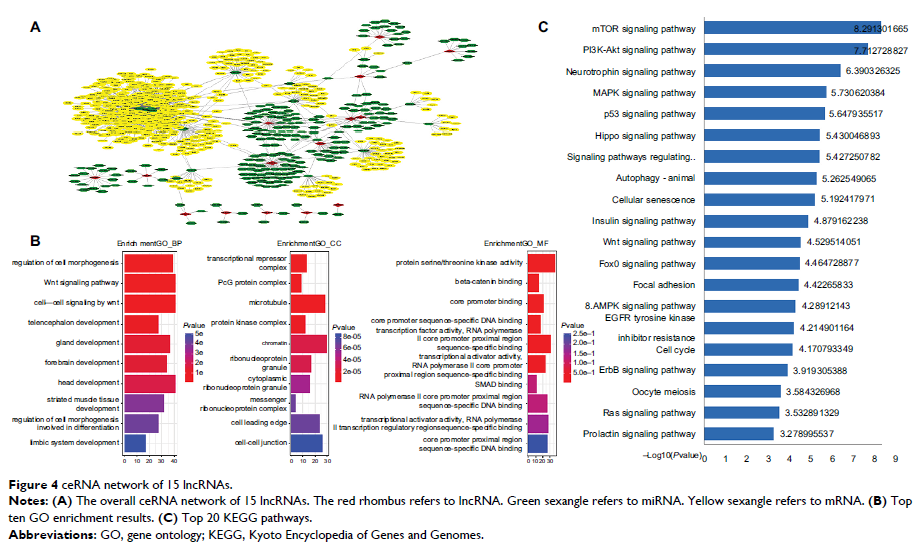9 1 2 3 6
论文已发表
注册即可获取德孚的最新动态
IF 收录期刊
- 2.6 Breast Cancer (Dove Med Press)
- 3.9 Clin Epidemiol
- 3.3 Cancer Manag Res
- 3.9 Infect Drug Resist
- 3.6 Clin Interv Aging
- 4.8 Drug Des Dev Ther
- 2.8 Int J Chronic Obstr
- 8.0 Int J Nanomed
- 2.3 Int J Women's Health
- 3.2 Neuropsych Dis Treat
- 4.0 OncoTargets Ther
- 2.2 Patient Prefer Adher
- 2.8 Ther Clin Risk Manag
- 2.7 J Pain Res
- 3.3 Diabet Metab Synd Ob
- 4.3 Psychol Res Behav Ma
- 3.4 Nat Sci Sleep
- 1.9 Pharmgenomics Pers Med
- 3.5 Risk Manag Healthc Policy
- 4.5 J Inflamm Res
- 2.3 Int J Gen Med
- 4.1 J Hepatocell Carcinoma
- 3.2 J Asthma Allergy
- 2.3 Clin Cosmet Investig Dermatol
- 3.3 J Multidiscip Healthc

15-lncRNA 特征可预测结直肠癌患者的存活并发挥 ceRNA 功能
Authors Wang X, Zhou J, Xu M, Yan Y, Huang L, Kuang Y, Liu Y, Li P, Zheng W, Liu H, Jia B
Received 29 June 2018
Accepted for publication 27 September 2018
Published 16 November 2018 Volume 2018:10 Pages 5799—5806
DOI https://doi.org/10.2147/CMAR.S178732
Checked for plagiarism Yes
Review by Single-blind
Peer reviewers approved by Dr Andrew Yee
Peer reviewer comments 3
Editor who approved publication: Professor Nakshatri
Purpose: Colorectal
cancer (CRC) is one of the most common malignant tumors worldwide. This study
aimed to explore the prognostic value of lncRNAs in CRC.
Material and methods: We
performed gene expression profiling to identify differentially expressed
lncRNAs between 51 normal and 646 tumor tissues from The Cancer Genome Atlas
database. Cox regression and robust likelihood-based survival models were used
to find prognosis-related lncRNAs. A lncRNA signature was developed to predict
the overall survival of patients with CRC. In addition, a receiver operating
characteristic curve analysis was performed to identify the optimal cutoff with
the best Youden index to divide patients into different groups based on risk
level.
Results: Eighty
survival-related lncRNAs were identified and a 15-lncRNA signature was
developed on the basis of a risk score to comprehensively predict the overall
survival of patients with CRC. The prognostic value of the 15-lncRNA risk score
was validated using the internal testing set and total set. The risk indicator
was shown to be an independent prognostic factor (hazard ratio =2.92; 95% CI:
1.73–4.94; P <0.001).
Notably, all 15 lncRNAs (AC024581.1, FOXD3-AS1, AC012531.1, AC003101.2,
LINC01219, AC083967.1, AL590483.1, AC105118.1, AC010789.1, AC067930.5,
AC105219.2, LINC01354, LINC02474, LINC02257, and AC079612.1) were newly found
to correlate with the prognosis of patients with CRC. Furthermore, the function
of 15 lncRNAs was explored through the ceRNA network. These lncRNAs regulated
coding genes that were involved in many key cancer pathways.
Conclusion: A
15-lncRNA expression signature was discovered as a prognostic indicator for
patients with CRC, which may act as competing endogenous RNA (ceRNAs) to play a
crucial role in the modulation of cancer-related pathways. These findings may
allow a better understanding of the prognostic value of lncRNAs.
Keywords: long noncoding
RNA, colorectal cancer, survival, biomarker, competing endogenous RNA, ceRNA
